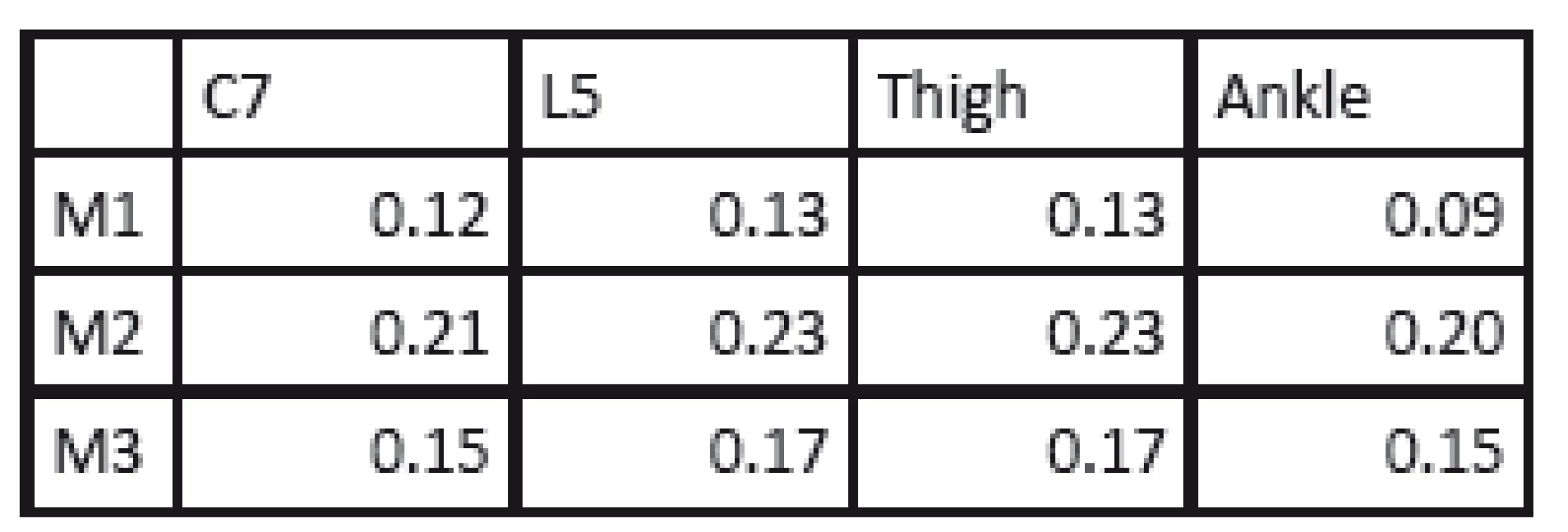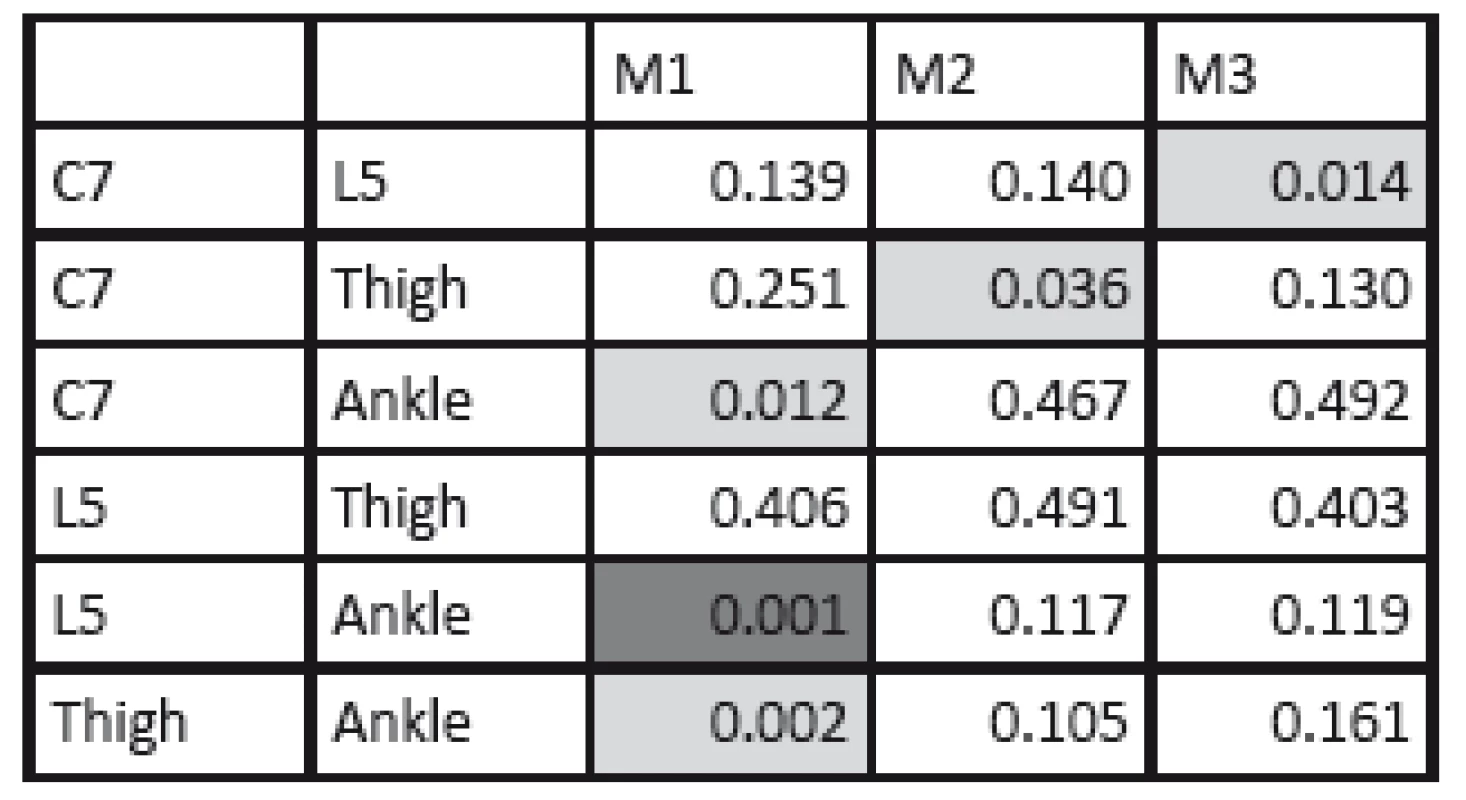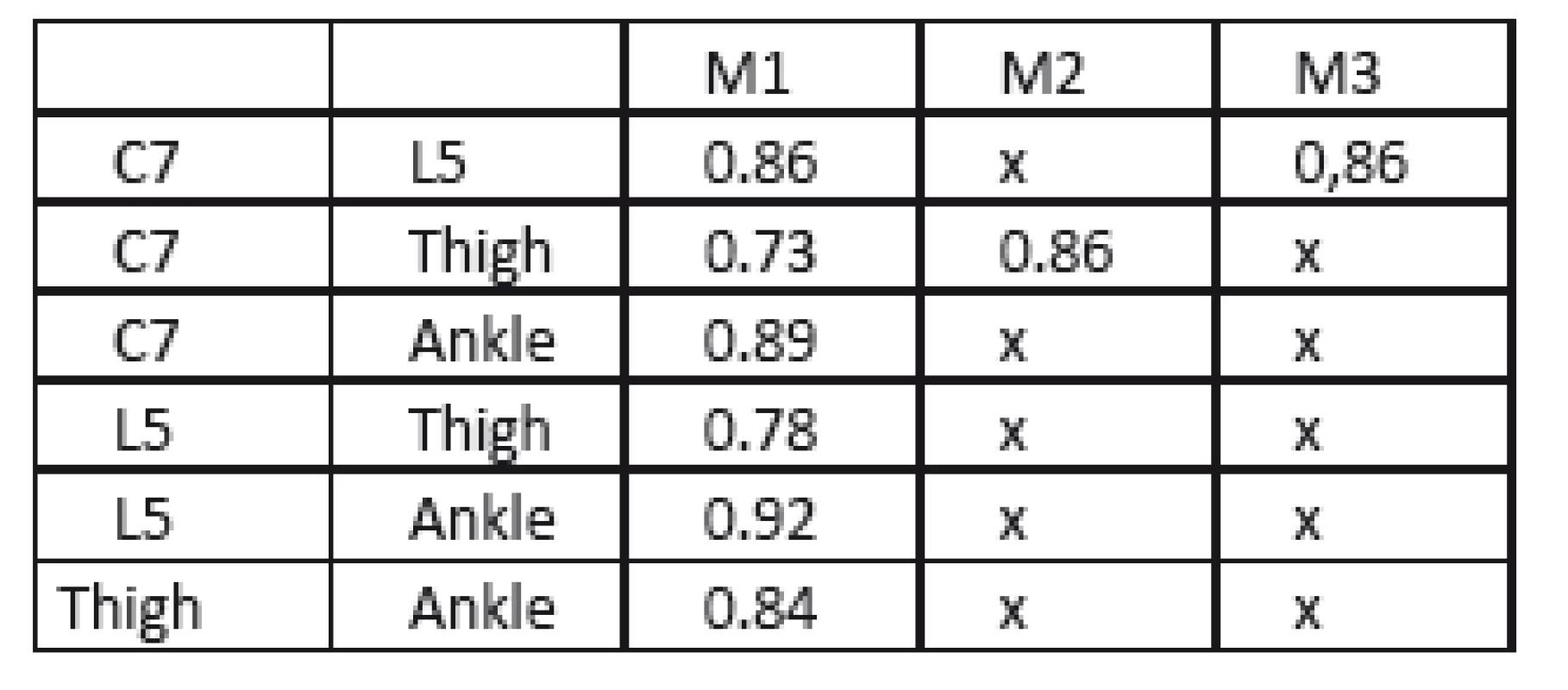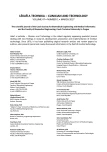BIOFEEDBACK AS A NEUROBIOMECHANICAL ASPECT OF POSTURAL FUNCTION
Authors:
M. Stredova 1; M. Sorfova 1; V. Socha 2; P. Kutílek 2
Authors‘ workplace:
Faculty of Physical Education and Sport, Charles University in Prague, Czech Republic
1; Faculty of Biomedical Engineering, Czech Technical University in Prague, Czech Republic
2
Published in:
Lékař a technika - Clinician and Technology No. 1, 2017, 47, 19-22
Category:
Original research
Overview
The aim of the work is to elucidate if there is a significant difference between the ability to maintain balance with or without the biofeedback while standing and identify specific segments that takes place of motion solutions of postural problems. We measured postural parameters using 6 tri-axial accelerometers placed in 6 places: 2× lower leg, 2× thigh, processus spinosus vertebrae L5 and C7. Probands absolved 3 postural tasks and 3 dynamic tasks. Postural: quiet standing with feet apart with eyes open, quiet standing with feet together with eye closed, quiet standing with feet apart with eyes open and with visual biofeedback. We used system Homebalance - interactive system for providing of balance training with visual biofeedback. Results show no significant difference between C7 and L5 for task without VBF (visual biofeedback) and with VBF, but SD VPG (sum of scatter of the acceleration) for thigh and ankle show significant difference between each task on every level. We detected that in open eyes majority of probands used ankle-strategy for maintaining balance. In eyes closed they preferred knee and hip strategy. The biggest accelerations were detected in C7 in eyes closed. Due to visual biofeedback patients are more motivated and they improve their skills faster than without visual biofeedback exercise. Strategy of maintaining balance during tasks with open eyes and eyes closed is different.
Keywords:
postural stability, visual biofeedback, X Sens
Introduction
Postural stability and its disorders is very important phenomenon in which many types of research is focused. The reason is to understand the processes of maintaining our body in balanced position.
The aim of this study is to identify a specific segment that takes place of motion solutions of postural problems. The aim of the work is to elucidate if there is a significant difference between the ability to maintain balance in the healthy population with or without the biofeedback while standing and identify specific segments that takes place of motion solutions of postural problems.
The uniqueness measuring postural function that moves the segments are small scale, but with greater frequency changes. And detection of these changes is crucial information strategy postural system. The wider range of variability detect motion, the greater the energy intensity.
Acceleration of the movement is the change of movement (determinated by kinematic and dynamic values) but also the energy invested in the process of maintaining stability. If the body is stable, the acceleration of the movement is fluent and less challenging for maintaining balance.
Experimental
We measured postural parameters using 6 triaxial accelerometers and main unit - X MoCap Xbus kit and force platform with visual biofeedback (VBF) - Homebalance. We placed accelerometers in 6 places: 2×lower leg, 2×thigh, processus spinosus vertebrae L5 and C7.
X Sens
X Sens is new 3D motion tracking technology used in last years. Its accuracy is compared to motion capture systems, it is easy to use and portable.
The MTx measurement unit consists of 3D gyroscopes, 3D accelerometers and 3D magnetometers (38×53×21 mm, 30 g). The sensor modules are connected to the Xbus Masters, which synchronizes all sensor sampling, provides sensors with power and handles the wireless communication with the PC or laptop [1, 2].
Homebalance
Homebalance is interactive system for home-based therapy of balance disorders. It provides balance training with visual biofeedback, which is low-cost and portable. It consists of tablet, portable stabilometric platform and diagnostic and therapeutic software providing gemlike therapy [3].
Experiment
Probands absolved 3 postural tasks and 3 dynamic tasks. Postural: quiet standing with feet apart with eyes open (M1), quiet standing with feet together with eye closed (M2), quiet standing with feet apart with eyes open and with visual biofeedback (M3). Dynamic: Shifting center of gravity (COG) while standing with feet apart with eyes open according to a biofeedback (M4–6). Tasks were repeated twice in the same order.
We tested 10 healthy subjects without CNS, rheumatoid or other disease: 6 women, 4 men, age 28.5 (SD ± 2.953341), height 172.3 cm (SD ± 10.40353), weight 67.4 kg (SD ± 8.33).
We evaluated parameter SD VPG (sum of scatter of the acceleration in measured segments in 3D which shows changes in acceleration in every directions of Cartesian system) and score from the VBF tasks.
Results
We evaluated statistical difference between statics tasks: eyes open (M1), eyes closed (M2), eyes open with biofeedback (M3) with two sample t-test and we tested each horizontal line (ankle, thigh, lumbar spine, cervical spine) – Tab. 1.

Results show no significant difference between C7 and L5 for task without VBF (M1) and with VBF (M3), but SD VPG for thigh and ankle show significant difference between each task on every level.
In eyes closed are deviations of the posture bigger compared to open eyes. This is commonly described phenomenon in many studies about posturography. We detected that in open eyes majority of probands used ankle-strategy for maintaining balance. In eyes closed they preferred knee and hip strategy. The biggest accelerations were detected in C7 in eyes closed.


The second repetition of dynamic tests with VBF shows best score for second than the first measurement.
Pearson‘s correlation coefficient points on mutual relation of SD VPG on each horizontal level. It proved only one significant correlation on L5 between M1 and M2. We have observed if there is small SD VPG by M1, there is small SD VPG by M2. The thigh has overturn values in comparison M2 and M3.

Results show for M1 significant difference of SD VPG for ankle in comparison with each other segment. For M2 the only significant difference of SD VPG between thigh and C7. For M3 the only significant difference of SD VPG between L5 and C7. Pearson’s correlation coefficient shows the same conclusion (table 5 below).



Discussion
Tasks with VBF shows greater SD of VPG (sum of scatter of the acceleration in measured segments in 3D which shows changes in acceleration in every directions of Cartesian system) than without VBF. That show us that the conscious correction of the COP interfere to cortical system of motoric control and for the whole body isn´t exactly natural situation.
In eyes closed are deviation of the posture bigger compared to open eyes. This is commonly described phenomenon in many studies about posturography. We detected that in open eyes majority of probands used ankle-strategy for maintaining balance. For level L5 and C7 uses the same movement stabilization strategy during M1 as during M3 (with VBF - visual biofeed-back).
In eyes closed they preferred knee and hip strategy. The biggest accelerations were detected in C7 in eyes closed.
There are discussion about which region of the body is most important to maintain postural functions. It has been considered, that ankle has an significant importance for maintaining balance [4, 5]. If there is functional instability in ankles, our capability to maintaining balance is affected. Precisely focused training for ankles has an important influence on balance [6]. It has been described, during 4 week postural training with VBF, there is improvement of anteroposterior sway velocity, which is dominated by ankle strategy. Improving ankle strategy control during tasks is probably the first sign of improvement in the static balance [7].
In our study we find out knee and hip strategy is preferred in eyes closed (M2).
The second repetition of dynamic tests with VBF shows best score for second than the first measurement. It matches with Bisson findings that balance training with virtual reality VBF has significant improvement in decreation reaction times of training tasks and postural sway in quiet standing [8, 9]. There is applied also experience and training form of coping with unknown form of required movement of COP due to task known as motor learning capability [10].
There are plenty of clinical studies proving, that training balance strategy with VBF is efficient and has great progress for stability parameters, especially with elderly people or patients with CNS disease [7–10].
Polskaia et al. [11] demonstrated that diverting attention away from a postural task to a continuous cognitive task appears to be more advantageous and natural for stability than using VBF. Lajoie et al. [12] share opinion, that requirements of standing in standardized /directed position may be disadvantageous for the study of postural control. However, Massenzo and Pidcoe´s study [13] shows that visual biofeedback in postural training is an incorporation of sophisticated approach in healthy participants. Jehu et al. [14] add that magnifying the scale of VBF improves posture. Kolleger et al. [15] found that vision as a stabilizing factor is in all age groups important and an interesting finding was, that visual control is more essential for men than for women.
Using IMU with 3D data analysis is cheaper and better diagnostic device than traditional posturography, which uses only 2D data [16]. These techniques are both standardized and reliable, but we can´t compare 2D and 3D data. That could cause disagreements with studies conducted in 2D.
Conclusion
Intentional correction of the COP interfering the motoric control process which isn´t exactly natural situation. That is probably the reason of greater VPG with VBF. However, we consider impact of VBF as very important, cheap and available type of biofeedback. Due to VBF (visual biofeedback) patients are more motivated and they improve their skills faster than without visual biofeedback exercise. Strategy of maintaining balance during tasks with EO and EC is different and is the subject for further researches.
Acknowledgement
The work has been supported by SVV 2017-2019-260346 and PRVOUK P38.
Mgr. Michaela Středová
Department of Biomechanics
Faculty of Physical Education and Sport
Charles University in Prague
José Martího 31,
Praha 6, 162 52,
Czech Republic
E-mail: michaela.stredova@centrum.cz
Phone: +420 773 668 828
Sources
[1] Roetenberg, D., Henk L., Per Slycke.: Xsens MVN: full 6DOF human motion tracking using miniature inertial sensors. Xsens Motion Technologies BV, Tech. Rep (2009).
[2] Damgrave, R.G.J., Lutters, D.: The drift of the xsens moven motion capturing suit during common movements in a working environment. Proceedings of the 19th CIRP Design Conference–Competitive Design. Cranfield University Press, 2009.
[3] Janatova, M., et al.: The Pilot Study of the Use of Force Platform in Home-based Therapy of Balance Disorders. Ceska a slovenská neurologie a neurochirurgie 79.5 (2016): 591–594.
[4] Strejcová, B., Šimková, L., Baláš, J.: Ankle isokinetic strength and postural stability in slackliners. Česká kinantropologie/Czech kinanthropology/ 16.3 (2012).
[5] Véle, F., Pavlů. D.: Test dle Véleho, neboli Véletest. Rehabilitation & Physical Medicine/Rehabilitace a Fyzikalni Lekarstvi 19.2 (2012).
[6] Rozzi, S.L., et al.: Balance training for persons with functionally unstable ankles. Journal of Orthopaedic & Sports Physical Therapy 29.8 (1999): 478–486.
[7] Sihvonen, Sanna E., Sarianna Sipilä, Pertti A. Era.: Changes in postural balance in frail elderly women during a 4-week visual feedback training: a randomized controlled trial. Gerontology 50.2 (2004): 87–95.
[8] Bisson, E., et al.: Functional balance and dual-task reaction times in older adults are improved by virtual reality and biofeedback training. Cyberpsychology & behavior 10.1 (2007): 16–23.
[9] Young, W., et al.: Assessing and training standing balance in older adults: a novel approach using the ‘Nintendo Wii’Balance Board. Gait & posture 33.2 (2011): 303-305.
[10] Jessop, R.T., Horowicz, C., Leland, E.D.: Motor learning and Parkinson disease: refinement of movement velocity and endpoint excursion in a limits of stability balance task. Neurorehabilitation and Neural Repair 20.4 (2006): 459–467.
[11] Polskaia, N., et al.: Continuous cognitive task promotes greater postural stability than an internal or external focus of attention. Gait & posture 41.2 (2015): 454–458.
[12] Lajoie, Y., et al.: Letter to the Editor: On Advantages and disadvantages of stiffness instructions when studying postural control by CT Bonnet: You just can’t win: Advantages and disadvantages of the postural stability requirement. Gait & posture 46 (2016): 215–218.
[13] Massenzo, T., Pidcoe, P.E.: Investigating the Impact of Visual Biofeedback on Postural Control Via Informative Dynamic Balance Training in Healthy Individuals. Int J Phys Med Rehabil 3.275 (2015): 2.
[14] Jehu, D.A., Thibault, J., Lajoie, Y.: Magnifying the Scale of Visual Biofeedback Improves Posture. Applied psychophysiology and biofeedback 41.2 (2016): 151–155.
[15] Kollegger, H., et al.: Spontaneous body sway as a function of sex, age, and vision: posturographic study in 30 healthy adults. European neurology 32.5 (1992): 253–259.
[16] Melecky, R., et al.: Quantification of Trunk Postural Stability Using Convex Polyhedron of the Time-Series Accelerometer Data. Journal of healthcare engineering 2016 (2016).
Labels
BiomedicineArticle was published in
The Clinician and Technology Journal

2017 Issue 1
Most read in this issue
- THE USE OF NONINVASIVE DIAGNOSTIC METHODS IN THE ASSESSMENT OF POSTURAL CHANGES IN UNIVERSITY STUDENTS
- BIOFEEDBACK AS A NEUROBIOMECHANICAL ASPECT OF POSTURAL FUNCTION
- USING PVDF FILMS AS FLEXIBLE PIEZOELECTRIC GENERATORS FOR BIOMECHANICAL ENERGY HARVESTING
- THE EFFECT OF FLUID ACCUMULATION IN STOMACH ON ELECTRICAL IMPEDANCE TOMOGRAPHY IMAGE OF LUNGS
